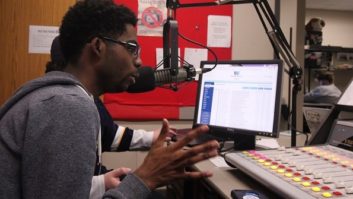Broadcast Engineering Conference
- Monday morning April 14 — “Communicating With Management”
- Monday afternoon April 14 — “Alternative STL Technologies”
- Monday afternoon April 14 — “Digital Radio Summit”
“Communicating With Management” would at first seem to be mundane. After all, virtually everyone has communicated with a manager, so what more can be said on the subject?
TALK, TALK, TALK
Quite a bit, actually — a successful radio operation is not the same as selling furniture or refining oil, and an experienced broadcast manager has valuable insight worthwhile to other broadcasters.
(click thumbnail)Paul F. Tinkle, president of Thunderbolt Broadcasting Company, is among the participants in ‘Communicating With Management.’“Having worked in radio for almost 40 years, I’ve seen a number of changes,” said Paul Tinkle, president of Thunderbolt Broadcasting Co.
“Management today has to be more involved with technology than ever before and must have a passion to learn about changing technology.”
The latest approaches to broadcast management will be reviewed in this session.
Love it or otherwise, HD Radio is changing the landscape of broadcasting and new rules are being written as the technology rolls out. Techniques and tools for managers have to keep pace with the technology to keep broadcasters afloat in a changing, competitive environment.
“It’s very difficult knowing when to pull the trigger on HD in a small market, especially because of costs and programming, but being aggressive is the key to being successful in this business,” Tinkle said. “You can’t sit back here — there is no more spectrum.”
Other participants in this 90-minute session include John Bisset, northeast regional sales manager for Broadcast Electronics and RW’s Workbench columnist; David Israel, vice president and general manager for WFYV(FM) and WMXQ(FM); Don Kelley, vice president and director of programming for Greater Media; and Gary Kline, VP of engineering and IT for Cumulus Media. The moderator is Chriss Scherer of Radio magazine, recent past president of the SBE.
Getting the right equipment and systems in place for the best sound and most efficient operation is only part of the game. Management’s ability to forge a team from different personalities is an essential part of the creative process of radio, including engineering management.
Tinkle has spent 40 years in broadcasting, starting as a janitor at stations he now owns. Coming up through the ranks, he dealt with every fad and new technology since the heyday of top-40 radio — and the personalities associated with it — in the 1960s.
“Anyone who has not spent at least 10 years in radio and doesn’t have a good engineer or consultant to be able to be an important resource will likely be left behind,” Tinkle said. “Engineers and managers must be constantly thinking of how to improve their facilities and how to do it with the available resources.”
Like any area of study, there are always new things to learn and veterans who have priceless experience. “Communicating With Management” will bridge the past with the present in a fast-changing radio world.
GET IT THERE
“Alternative STL Technologies” will examine the evolving requirements for studio-transmitter links. Radio in a digital world is making demands on STLs that are just as dramatic as the switch from mono to stereo.
“With the advent of HD Radio, the bandwidth requirements have gone up exponentially,” said Paul Shulins, director of technical operations for Greater Media. “No longer will a simple phone line or single T1 suffice.”
Making the most of your current STL and planning for the future will be discussed.
With radio stations now broadcasting multiple streams of programming, stations are being squeezed by listeners expecting more content at the same time competition from satellite services is biting into broadcasters’ budgets. Making the most of current technology for your STL is not only necessary to handle additional programming, it will help hold the line on costs.
“Having an IP link to the transmitter site is the wave of the future,” Shulins said. “In fact most equipment manufactured today either requires or offers some kind of network connectivity — if not for operation, then for installation and maintenance.”
However, different broadcasters have different needs, and another approach may fit your requirements best.
“There are emerging technologies offering different solutions at widely different costs, and offering widely different reliability,” Shulins said.
The presentation will kick off with Bob Band from Harris Corp., who will discuss HD Radio and its need for increased STL bandwidth.
Band will review technologies such as spread-spectrum radios, T1 radios, IP links and traditional 950 MHz links. His presentation is “The HD Radio STL: Issues, Options and Technologies.” Formerly with Intraplex, where he was technical communications manager and webmaster before moving into international sales and marketing, he now works in business development for Harris.
Guy Gampell from APT will present what many consider to be the future of audio transport: audio over IP. His talk is “The Best of Synchronous with the Best of IP.”
Although it is a major advance in capabilities, this technology is still developing, and today’s users must be aware of its limitations, benefits and requirements. Gampell promises to give an overview of the most important issues that broadcasters need to consider before embarking upon IP migration.
Finally, in “Robust HD Radio Exporter to Exgine Architecture,” Tim Anderson from Harris will examine the new generation of I2E and E2X HDP data-stream protocols.
This compression technology can improve the robustness of the UDP/IP-over-Ethernet protocol that allows broadcasters to use simplex and lower-bandwidth STLs.
The choices are diverse: radios or IP? Phone company or fiber? “Alternative STL Technologies” will give an understanding of how these technologies affect your station.
AT THE SUMMIT
(click thumbnail)Barry Thomas, vice president of radio engineering for Lincoln Financial Media and new SBE president, chairs a ‘Digital Radio Summit.’Capping off Monday’s radio sessions is the two-hour “Digital Radio Summit.” Chaired by Barry Thomas, vice president of radio engineering for Lincoln Financial Media and president of the SBE, this session will cover a range of radio-related topics, from technical to regulatory.
“These [presentations] will be an important resource in understanding digital radio’s challenges and opportunities in the U.S. and overseas,” Thomas said.
Presentations begin with “Bandwidth & Frequency Allocation Issues in International Digital Radio AM & FM Broadcasting,” by Chuck Kelly, director of international sales for Nautel.
Kelly will examine how broadcasters and regulators are dealing with issues of occupied bandwidth, and the impact of DRM and HD Radio implementation on co-channel and adjacent-channel interference. Theoretical and real-world examples from domestic and international broadcasters will be presented.
“New Standards and Codecs for European Digital Broadcasting” is by Olaf Korte from the Fraunhofer Institute for Integrated Circuits in Erlangen, Germany. This presentation will review the background of DAB, DRM and DMB, and their operational appeal to both public and private broadcasters in Europe.
Although there are efforts being made to introduce HD Radio to Europe, the fragmented European market makes it difficult to establish a common digital radio standard for the entire continent.
“Mobile Coverage Optimization by Polarization Diversity in VHF and UHF Propagation,” by Myron Fanton, chief engineer for RF Technology at Electronics Research Inc., will discuss how different transmission antenna polarizations can affect channel capacity and performance.
With the correct antenna design and proper modulation, two independent signals may be transmitted and received on the same frequency. At the receiving end, dual-polarized antennas have been found to dramatically increase mobile signal reception and virtually eliminate signal loss, both in digital television and radio IBOC broadcasts.
A somewhat lighthearted look at the evolving lingo of broadcasting is the focus of “Does Your Yotta Byte?,” by Andrew Janitschek, director of production support for Radio Free Asia.
Terms such as gigabyte, terabyte, 1080p, HD Radio, HDMI, and voice-over-IP are now part of our everyday engineering language, despite being virtually unknown just a few years ago. And as analog NTSC television faces a government-enforced sunset, will quaint terms like AM, FM and subcarrier be the next to disappear from the lexicon of broadcasting?
Janitschek will examine some new broadcast technologies and the associated terms we will all use in the future.
Bob Kovacs, a former DJ and radio engineer, is a regular contributor to TV Technology magazine whose photography has also appeared in RW.









